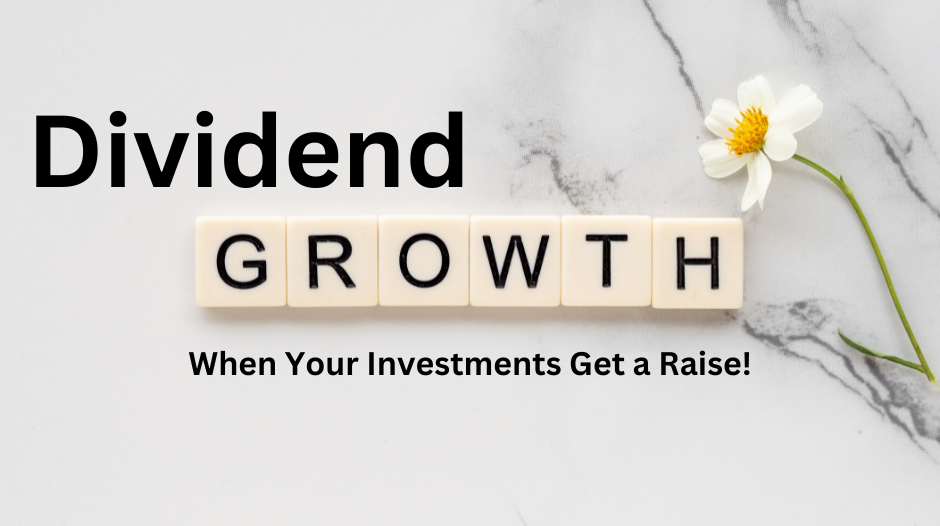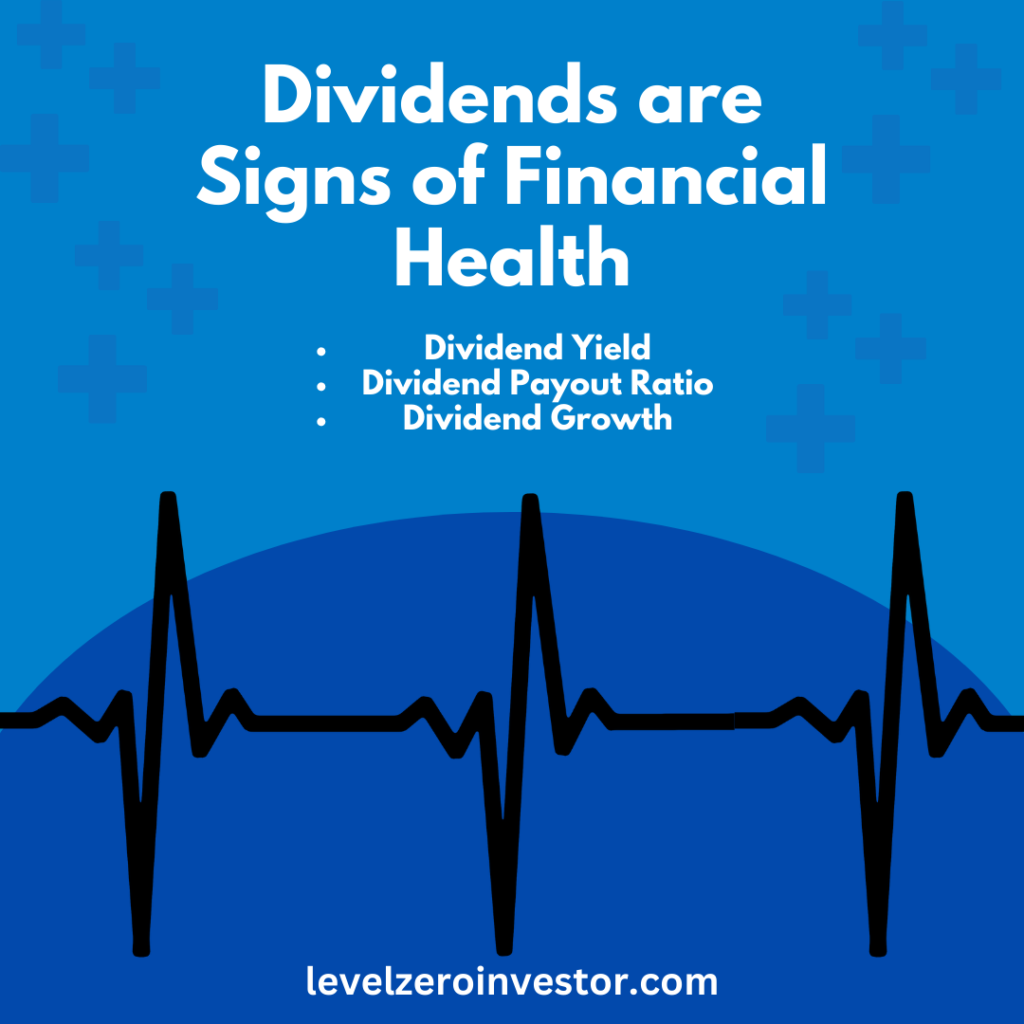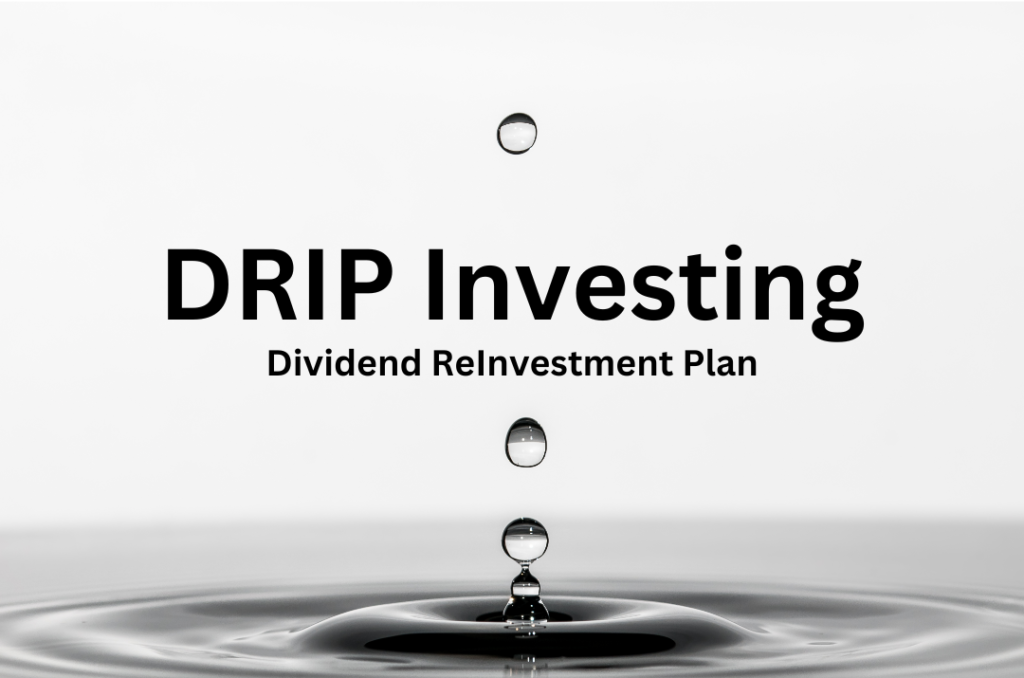Dividends grow! A simple concept, yet so powerful. Dividend Growth is just one more way that wealth can be gained within the Stock Market. Dividend Growth is also a great metric when valuing a company.
Dividend Growth is when the payment of the dividend increases. When a company decides to change the amount of a dividend, it reflects more than just payments to shareholders, it represents a high-level representation of the company. More so, it is a telling sign of a company’s financial health. The growth of a dividend is tied closely with the other 2 pillar metrics of dividends: yield and payout ratio. Even more importantly, companies that have shown historical Dividend Growth tend to be favored more by investors.

Because of the popularity of dividends, the Dividend Growth strategy is very popular. Even to the point where ETFs and Index Funds have been created specifically around companies that value Dividend Growth.
How does an investor glean so much information from one aspect of dividend investing? Continue reading below to see how your investments can get a raise from Dividend Growth.
Dividend Review – What is a Dividend?
Before we begin, a quick high-level overview of what is a dividend needs to be reviewed.
A dividend is another term for payment, more specifically a payment from a company to its investors or shareholders.
Dividends are one way that a company can reward its shareholders for investing in that company. The other way a company rewards its shareholders, increase in share price. However, a company has little control over its share price compared to its dividends.
Which is why we analyze the 3 pillars of a dividend: yield, payout ratio, and growth.
To read more about dividends and the other two pillars you can find those articles here:
Now, lets get back to the star of the show, what is Dividend Growth?
What is Dividend Growth?
Dividend Growth measures the change or increase in the size of the dividend payment.
Typically you’ll see a company increase its dividend once a year. This might vary from company to company and sector to sector, but for the most part, it happens once per year.
Depending on the past performance and future estimates of a company, it can decide to increase (or decrease) the dividend. Increasing the dividend alongside growing estimates demonstrates how a company is willing and able to share its profits with shareholders.
Why is Dividend Growth Important?
Why do we care about a dividend growing?
As mentioned in the title, your investments are getting a raise!
Honestly, it’s the best kind of raise. You, the investor, took your hard-earned money and purchased a share of a company. That company decided to reward you by sharing their profits as a form of a dividend. To top it off, while you sit and do nothing…the company raises its dividend payment and you get even more money from your investment.
A raise for doing nothing. Sign me up.
But it’s more than just getting more money per dividend payment. We’re investing for the long run. We want to invest in companies that we can own forever and will grow forever.
So what can we learn from Dividend Growth?
Signs of Financial Health

I mentioned in a previous article that the Dividend Payout Ratio is a good “health metric” for a dividend. Well, we can also determine the financial health of a company by its Dividend Growth.
When a company decides to pay a dividend, it comes from their earnings. A company that can continue to grow earnings is looked at favorably.
Therefore, if a company feels comfortable enough to increase its dividend payment, it must feel as though its earnings are growing enough to offset the dividend.
On the other hand, if we see little to no growth…or even decreases…in the dividend payments, that is a big red flag. A company is signaling that either hardships are coming, they do not project as high of growth, or they need extra capital to reinvest back into the company.
Regardless of the reason, insights can be drawn from the changes in their dividend payments.
Dividend Growth Correlation Between Yield and Payout Ratio
Dividend growth, dividend yield, and dividend payout ratio are interrelated concepts that provide valuable insights into a company’s dividend policy and its financial health. While they are distinct measures, understanding their correlations can help investors gain a comprehensive understanding of a company’s dividend profile.
As stated earlier of signs of financial health, a higher dividend growth rate indicates a healthier and more prosperous company, as it demonstrates consistent profitability and potential for future dividend increases.
Dividend yield, is the ratio of the annual dividend per share to the stock price. It measures the income generated by an investment relative to its price. Dividend yield is often viewed as a measure of current income, and it can fluctuate based on changes in the stock price or dividend payments. Generally, a higher dividend yield indicates a higher income return on investment.
The relationship between dividend growth and dividend yield can be inversely related. A company with a high dividend growth rate may have a lower dividend yield if its stock price has experienced significant appreciation. Conversely, a company with slower dividend growth or a declining stock price may have a higher dividend yield.
The dividend payout ratio is a measure of the proportion of a company’s earnings that is distributed as dividends. It is calculated by dividing the annual dividends per share by the earnings per share. A low payout ratio suggests that a company retains a larger portion of its earnings for reinvestment, while a high payout ratio indicates a larger portion of earnings is being paid out as dividends.
The relationship between dividend growth and dividend payout ratio is often positive. A company that consistently increases its dividends over time typically has a sustainable payout ratio, which means it retains sufficient earnings to support future dividend growth. On the other hand, a high payout ratio can limit a company’s ability to increase dividends in the future.
While dividend growth, dividend yield, and dividend payout ratio are interconnected, they provide different perspectives on a company’s dividend policy. Investors should consider all three measures together, along with other factors such as the company’s financial health, industry dynamics, and management’s commitment to shareholder value, to make well-informed investment decisions.
History of Dividend Growth
What’s even better than growing dividend payments? A long history of growing dividend payments!
Many companies have great track records of increasing their dividends. There are a couple of reasons why they want to continue to increase those dividends.
Inflation – Dividends Losing Value
One of the top reasons to invest is to fight inflation. On average, inflation increases by about 2%-3% each year. With that in mind, if you were to receive a dividend one year and the size of the payment remains the same year-over-year, that dividend will eventually lose its value.
If dividends are meant to be one way a company rewards its shareholders, losing value is never a good strategy for keeping shareholders happy.
Dividend Status
Having a long history of increasing dividends can have a company earn certain titles. These titles/statuses are good for companies as they are signs of recognition as well as demonstrating to investors that they should invest in their company due to their long track record of increasing dividends.
These dividend titles are (along with some example):
- Dividend Aristocrats
- Dividend Aristocrats are companies that are part of the S&P 500 index and have consistently increased their dividends for at least 25 consecutive years. These companies are known for their stability and commitment to rewarding shareholders with regular dividend increases.
- Examples:
- Procter & Gamble (PG)
- Johnson & Johnson (JNJ)
- Coca-Cola Co. (KO)
- Dividend Kings
- Dividend Kings are companies that have increased their dividends for at least 50 consecutive years. This is a select group of highly established and reliable companies that have demonstrated a remarkable track record of dividend growth over several decades.
- Examples:
- 3M Company (MMM)
- Colgate-Palmolive Company (CL)
- Coca-Cola Co. (KO) … again
- Dividend Champions
- Dividend Champions are companies that have raised their dividends for a minimum of 25 consecutive years. This term is more inclusive than Dividend Aristocrats, as it includes companies outside the S&P 500 index.
- Examples:
- Exxon Mobil Corporation (XOM)
- Walmart (WMT)
- McDonald’s (MCD)
- Dividend Contenders
- Dividend Contenders are companies that have increased their dividends for at least 10 consecutive years but haven’t reached the 25-year threshold of Dividend Aristocrats or Dividend Champions.
- Examples:
- Cisco Systems, Inc. (CSCO)
- Target (TGT)
- The Home Depot (HD)
These titles and statuses are a big deal to these companies. To not raise or cut their dividend after raising 25 or 50 years or more would be a huge deal. This is why many investors, especially Dividend Growth investors, are drawn to these companies and their safe dividends.
Dividend Growth Investment Strategy
When a new investor starts, choosing a strategy can be quite hard.
To my surprise, I found that there is a huge community of Dividend Growth investors, who build their portfolios and strategies around companies that excel in Dividend Growth.
The principles behind this strategy are:
- Invest in companies that offer a dividend.
- Invest in companies that have a record in growing their dividend.
If this sounds familiar, read the section above on Dividend Kings, Aristocrats, etc. These are exactly the types of companies that draw Dividend Growth investors.
But why a focus on the dividends?
Dividends are Passive Income
Dividends are a form of passive income. You don’t need to do any work, and yet every quarter a company sends you a check.
At first, dividend payments are small, maybe around $1 per share. Can’t do much with $1, or $4 annually. But that’s the first part of the strategy. You start small and grow your dividends, reinvest your dividends, and soon those dividend payments don’t look too small anymore.
Of the S&P500 average annual returns of about 10%, roughly 3% is attributed to dividends. Using 3% as a baseline in this example, a Dividend Growth Investor could figure out how much they would need to invest to have that dividend as a sole passive income to cover expenses.
For example: when you retire, your average monthly expenses come out to $2,500 per month. With a 3% dividend yield, if you had $1,000,000 invested, your dividends could pay your monthly expenses. $1,000,000 * 3% = $30,000 dividends per year. $30,000 / 12 months = $2,500 per month.
The icing on top of this cake…you don’t need to sell any shares for income. 100% of your expenses come from dividends, not from selling assets.
Dividend Growth Valuation
The greatest investor of our time, Warren Buffett said, “Price is what you pay, value is what you get.” Determining a value for a company is important irregardless if you are a Dividend Growth investor, or Value investor, etc.
There is a specific Dividend Growth Valuation model, also known as Gordon Growth Model, which focuses on a company’s future dividends. It assumes that the value of a stock is equal to the present value of its expected future dividends, discounted at an appropriate rate.
There are advantages and disadvantages to using this model (much like any model).
- Advantages
- Simplicity: Since this model focuses on the dividend growth, you don’t need to look at any other factors like earnings, free cash flow, or other metrics. Makes it easy to use.
- Dividend Focus: Dividend Growth Investors find this model useful, because dividends are their primary focus/interest.
- Long-Term Perspective: Using this valuation model is for investors, not traders. The model will help determine the long-term outlook of the potential future growth of a dividend. This aligns with Dividend Growth Investors who utilize a buy-and-hold strategy.
- Disadvantages
- Dividend Dependency: The model is using future growth from the dividend, therefore a company that does not pay a dividend or has a track record of increasing its dividend will not benefit from this model.
- Sensitivity to Dividend Growth Rate: Small changes in the projected future of the dividend growth can have significant impacts on the value. One percentage point up or down plays a big role. Therefore, evaluating companies that have a wide range of increases may make it harder to evaluate. But it might be useful to a company that consistently increases by the same amount every year (but how often does that happen?)
- Ignoring Other Factors: The anti-advantage of “Simplicity” is that because this model only focuses on Dividend Growth, it does not take any other parts of the business, or macroeconomics, into the picture. An example would be the Discounted Cash Flow (DCF) model which pulls many factors such as cash flow projections, discount rate, and terminal value.
All valuation models have their advantages and disadvantages, it is up to the investor to choose which model suits their strategy and the company. You wouldn’t use the Dividend Model to valuate Tesla since they don’t offer a dividend.
Dividend Growth Funds – If Picking Individual Stocks Are Not For You
Using Valuation Models is great if you want to pick your stocks. Overpaying for a company is never ideal. However, some investors may not be interested in analyzing and choosing which dividend stocks to invest in.
Enter, Dividend ETFs and Index Funds.
For a quick explanation of Exchange-Traded Funds and Index Funds, they are a grouping of stocks put into one fund. An easy example is the S&P500 Index Fund, SPX, which is one fund that contains all 500(ish) companies in the S&P Index. For more details, you can read this article on, What is an ETF?
Since ETFs can come in all varieties, of course there are some that are created specifically for Dividends, High-Yield Dividends, Growth Dividends, etc.
The table below are just a few examples:
| Stock Symbol | Stock Description |
|---|---|
| VYM | Vanguard High Dividend Yield |
| SCHD | Schwab US High Dividend Yield |
| DGRO | iShares Dividend Growth |
| VIG | Vanguard Dividend Appreciation |
| DGRW | WisdomTree US Quality Dividend Growth |
| NOBL | ProShares S&P 500 Dividend Aristocrats |
Using ETFs can be an effective and simple way to gain access to many dividend stocks all in one spot. And rather than running valuation models to determine a price to buy these at, you can simply Dollar Cost Average into these funds. You can learn more by reading this article on Dollar Cost Averaging.
Summary
Dividend Growth refers to the increase or change in the size of the dividend payment over time.
Dividend Growth is one of the three main pillar metrics of dividends. Omitting one of these metrics when analyzing dividends will leave a gap in your analysis.
Since Dividend Growth, Yield, and Payout Ratio are all correlated, we can use these metrics to explain the changes and financial health of a company.
Dividend Growth is an important metric to consider when investing because as an investor, we like to see when our gains make gains. Over time, as a dividend grows, our initial investment gets a raise. This only helps the compounding growth effect of investing and growing wealth.
With many investing strategies available for investors, dividends are popular among many groups. Specifically, Dividend Growth investors who place a high value on dividends as a passive income that will only grow over time. Investors can use Valuation models and ETFs/Index Funds to build their portfolios around this strategy.
Growth is good. Raises are good. And when dividends get a raise, that is good.
Thank you so much for reading! Go out there and look for the next Dividend Aristocrat!
For more great advice for beginning investors, check out my most recent blog articles or if you need more inspiration to get involved with investing, read my Top 5 Reasons Why You Should Invest article.
Disclaimer
levelzeroinvestor.com is not a registered investment, legal or tax advisor or a broker/dealer. All investments / financial opinions expressed by levelzeroinvestor.com are from the personal research and experience of the owner of the site and are intended as educational material. Although best efforts are made to ensure that all information is accurate and up to date, occasionally unintended errors and misprints may occur.



Thanks for the post, Brett. You definitely hit all the right notes on dividend growth investing. You got me hooked from the start! 😄
Love the 3 pillars of dividends. This post was such a great reminder that as investors we shouldn’t solely be chasing after dividend yields. So true that all 3 are interwoven and probably the most overlooked is the payout ratio. Sustainability and growth go hand-in-hand.
Keep up the good work! 👍
Thanks for the kind words!
As I dove deep into the 3 pillars of dividend health metrics, it’s amazing how they’re correlated. You can learn so much about a company just by understanding these 3 metrics.
Bookmarked, so I can continuously check on new posts! If you need some details about Car Purchase, you might want to take a look at QH6 Keep on posting!